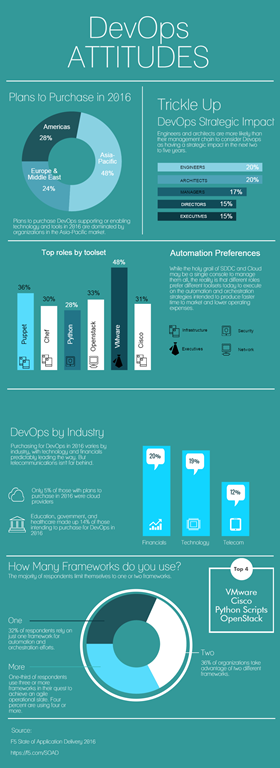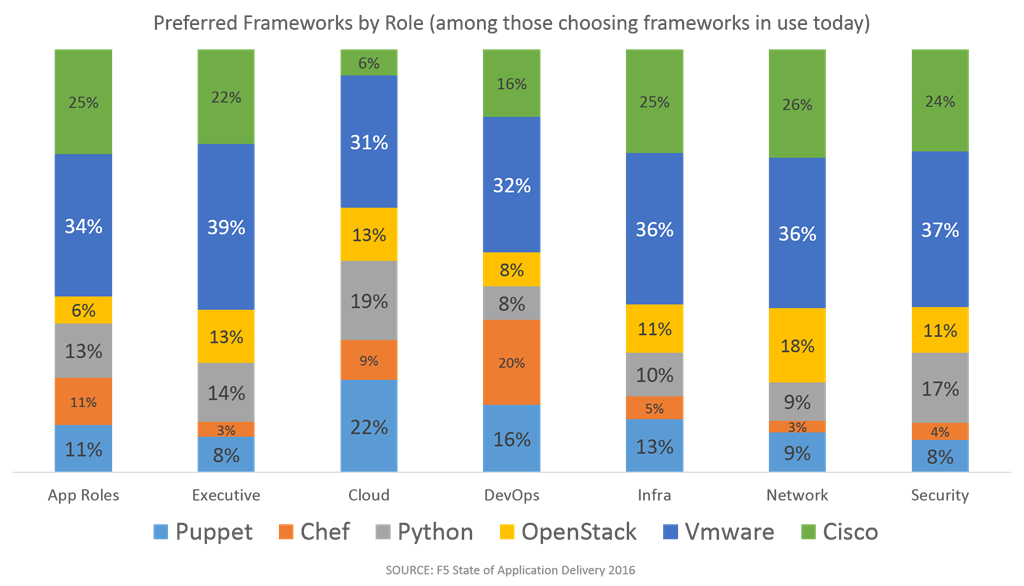2016 年のアプリケーション配信の状況: データセンターにおけるDevOpsとは多様性を意味する
アプリケーション配信の現状に関する調査で私が本当に気に入っていることの 1 つは、他の誰も答えられない質問に対する答えを見つけようとしていることです。 知っています、探したからです。 メリット(認識されているものと実際のもの)、採用率、指標に基づく改善を詳しく調査した、非常に優れた徹底的な DevOps 関連の調査がいくつかあります。
こうした調査は通常、ゲームに片足だけではなく足全体も関与している人によって実施されます。
これらの調査からは、DevOps の「自動化」の側面を実行するために誰が何を使用しているかに関する情報は得られません。
そこで、機会(およびすべてのデータ)が与えられたとき、私は数字を計算し、データを細かく分析して、それらの質問のいくつかに対する答えを見つけ始めました。

IT 階層において、DevOps が戦略的であると考える人と、そう考えない人はいますか?
エンジニアやアーキテクトは、経営幹部よりも DevOps が戦略的な影響を与えると考える可能性が高いと推測したなら、その通りです。 エンジニアの 20% とアーキテクトの 20% が DevOps を戦略的なものとして認識しましたが、これに同意したのは経営幹部の 15% とマネージャーの 17% のみでした。
なぜそれが重要なのでしょうか? DevOps は、文化 (「姿勢」) の変革と同じくらい自動化 (「実行」) に依存するアプローチであり、文化は上ではなく下に浸透する傾向があるためです。 経営陣が DevOps を戦略的なものとしてより強く支持し、信頼していなければ、組織は自動化のメリットを確実に享受できるものの、長期的には既存の文化的障壁から生じる同じ課題に悩まされることになります。

自動化とオーケストレーションにはどのようなフレームワークが好まれますか?
DevOps を戦略的なものと考える回答者の割合は低かったものの (17% のみ)、組織は自動化とオーケストレーションの価値を明確に理解しています。 大多数 (67%) は少なくとも 1 つの自動化およびオーケストレーション フレームワークを使用しており、半数以上は少なくとも 2 つを使用しています。
VMware は 23% が使用中と回答し、明確な勝者となったが、最近市場に参入したばかりの Cisco は、すでに 16% が使用中と回答しており、その優位性に挑戦している。 Python スクリプト (8%) は、人気の DevOps フレームワークである Puppet (7%) と Chef (3%) を上回りました。 オープンスタック 回答者の7%が使用しています。
業界によって違いは生じますか? あまりない。 VMware と Cisco を使用している主な業界は金融サービスと保険で、それぞれ 20% と 21% でした。 OpenStack と Puppet の最大のファンはテクノロジー企業 (21% と 22%) ですが、Chef はテクノロジー企業から最も多く使用されています (30%)。 ほとんどの新興テクノロジーやムーブメントと同様に、金融、テクノロジー、通信が先頭に立って、すべてのフレームワークで大部分の使用量を占めていることがわかります。
DevOps = 多様性
DevOps に関連するデータをどのように切り分けても、多様性が見つかりました。 データセンター全体にわたる多様な役割。 業界の多様性により、あらゆる企業が自動化フレームワークを使用しています (2016 年には DevOps 関連の製品を購入する予定です)。 そして用途の多様性。 半数以上が少なくとも 2 つのフレームワークを使用しており (29% が 3 つまたは 4 つを使用)、使用されている基本ツールセットにも多様性が見られます。
それは良いことです。DevOps ツール、フレームワーク、実践者からなる堅牢なエコシステムは、IT の最適化とビジネスの成長に役立つアプローチの継続的な成長と成熟を意味するだけだからです。
2016年のアプリケーション配信の現状は、f5.com/SOADからダウンロードできます。
